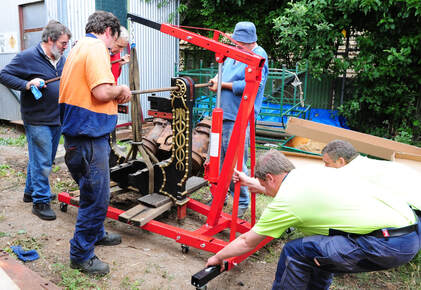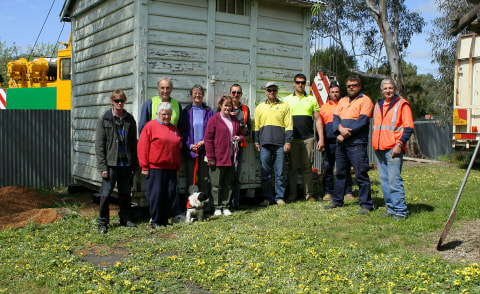|
On Friday November 25th 2011, five of our members made the trip to Central Deborah Goldmine in Bendigo to retrieve the old Columbian “Eagle” press. Little did any of us expect that it would take over 7 hours to dismantle, move and load the press from the shed onto the awaiting truck. Shown in the photo below are (From left): Bob Tomkins, Russell Searle, Rod MacKenzie and John Brissett. Howard Cooper, took the photo, and we thank him for taking all the photos in this posting. (Below) Project leader, Russell Searle is shown below inspecting the press prior to its dismantlement. It was important that we remembered where every part came from, and how it had to be reassembled. Howard photographed each part as it was removed, for later reference if that was needed. The beautiful brass plate at the centre of the press records the name and address of the manufacturer, Clymer and Dixon, of London. Unfortunately there is no serial number or date of manufacture on our press , but we believe it was manufactured around 1840. That would make it about 170 years old! The move-able balance beam from the top of the press took 4 strong men to move it. Lifting it up onto the truck presented another challenge. The main frame was the heaviest single part, and required some concerted teamwork. Glen Carter, from Central Deborah Goldmine is seen here in orange. His specialist knowledge and experience with moving heavy objects, and his additional physical strength were appreciated by our team. Finally with some extra help from Andrew Finnie, the truck driver, the main frame was coaxed up onto the truck for the journey back to Broadford. The Historical Society would like to thank:
Scaffolding went up and the security fence was errected at the end of May 2011. Since then the roof has been relined with a silver-foil lined insulation blanket, which is intended to reduce moisture in the air. and prevent rust forming on the machinery. All the signage has been redone on the top of the building, and timber work replaced or repaired behind it.
On Friday January 28th, several of our members turned up to welcome members of the Dandenong Valley Historic Car Club to our museum. The group was on a tour of the district, which also included the Seymour Railway museum. Apparently the members do these tours regularly, always looking for an excuse to take their wonderful old cars out for a run and to spend time with like-minded people. We were delighted to welcome them and to show them around our museum. Thanks to everyone concerned, members and visitors alike. It was a very pleasant day and we all appreciated the commitment and dedication required to preserve our respective historical interests.
Photos by John Brissett. Monday 10th January 2011, and another piece of Broadford history is gone forever! Stray’s Blacksmith Shop, a prominent and long-established Broadford landmark, was swept away by the demolition team in a few short moments. Howard Cooper and I managed to get down there with our cameras in time to record the final scenes. This is what we saw: It was all over in a few seconds! All that remained was a heap of rubbish! The early history of this building is unclear but it appears to be pre-WWII, and may be older. It was run by three generations of the Stray family and became a Broadford landmark over many decades. Norm Stray, now 71 and the son of the original owner, remembers happy times spent there in his childhood:
“We had a big black dog back then and I used to watch Dad rope it. Strapping the horses up and shoeing them, I used to practice by roping the big black dog and throwing him on the ground so I could shoe him. You know? Then of a night time after tea, Dad used to go back to the shed clipping shoes, and shaping shoes up for the next day. I used to go over there and when I got tired I lay down with the black dog, beside the fire and went to sleep.” It wasn’t an easy life though: “Then, Dad was pretty strict too. Dad and I [when I was older) used to work together. We could cut a piece of steel off and make a set of horse shoes. Dad and I could turn them, claw them and punch them, ready to be clipped in eight minutes! That was making them by hand. In later days it got too much. You had to buy them. You couldn’t keep up. We had up to 3 or 4 blokes working then. On a wet day all the trucks would be lined up. All the Shire trucks from [Broadford and ] Kilmore would be lined up waiting to get something done too. They were the “Good old days.” The shed finally closed on 16th February, 2009 and has been standing idle ever since. Efforts to preserve the building failed and most of the contents were sold off in a huge auction some time ago. Buyers came from near and far to get their hands on tools, machinery and trinkets from a bygone age. Today, January 10th, 2011, the building came down, and a team of asbestos-removing specialists carried off the remains of that old corrugated asbestos roof. The double doors off the front of the shed have been offered to the Historical Society and will be proudly displayed in the pavilion building. Norm Stray was interviewed by Ruth Davern and Gloria Cordingley from our society in 2010, and the whole of their interview was published in the Autumn edition of our newsletter. A recent grant from the Foundation for Rural and Regional Renewal has enabled the Broadford & District Historical Society to fulfil what had appeared to be an impossible dream. For ten years the Society had been trying to work out a way to relocate the old Broadford Police lock-up cell to its museum complex. The cell is believed to be over 100 years old, and was located behind the old police station in Broadford. Its removal raised some difficult issues. “We knew the cell consisted of a heavy iron ‘cage’ encased in heavy timber, but no one could tell us just how heavy it was,” Society President John Brissett reported. “Estimates of up to 12 tons were suggested, and this raised questions of who in the area had the heavy-lifting equipment to move it.” A grant of $500 was given to the Society some years ago by Seymour Rotary Club to assist with the move, but a lot more than this was needed to lift, move, relocate and repair the building. Community grants had been applied for but they excluded ‘moving costs’, and this appeared to be the major expense with the cell project, the cell having been given to the Society by Victoria Police. With limited funds and few apparent options available, the task was put ‘in the too-hard basket”, where it remained for a decade. Then the group heard of the C.A.T.C.H. (Culture Arts Tourism and Community Heritage Program) grants, run by a private charitable organisation that provided grants of up to $20,000 to not-for-profit community groups in rural and remote Australia. The grant application went in, and within a week of the notification of our success, the move happened. A 30 ton mobile crane from Seymour Cranes lifted the lock-up cell onto the Mitchell Shire’s low loader which rolled down the main street, providing much interest to those lucky enough to see it. Traffic was briefly held up as the truck negotiated power lines and other obstacles. The crane then gently positioned the building on its prepared site behind the pioneer cottages in the Historical Society’s museum precinct. Painting and repair work will commence shortly and will be carried out in conjunction with the repairs taking place on the 119 year old Courier newspaper office. This was the subject of another successful grant application by the Society some months ago. The Society would like to acknowledge the considerable community support it has received with the project, and particularly Mitchell Shire’s generous contribution of men and equipment to facilitate the move. 21 November 2010
Photos by Peter Wright and Howard Cooper |



























